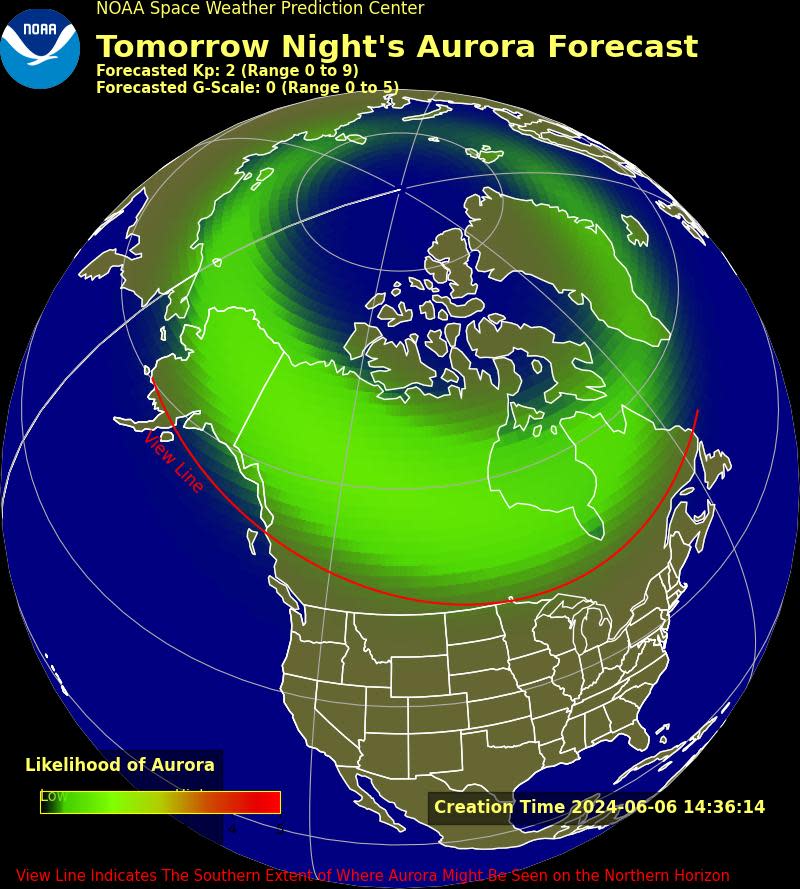Not to be cliche, but don’t get your hopes up when it comes to a repeat view of the northern lights, at least not from Florida.
While residents of the Sunshine State got a great view of the aurora borealis May 10 — which was visible as far south as Puerto Rico — some conditions just aren’t lining up for this week.
But nothing is for sure and “that’s why aurora predictions sometimes fail and we won’t know until it’s almost here,” according to the Old Farmer’s Almanac.
Experts agree, saying even the best predictions can only accurately be made a few days or even hours in advance.
Aurora borealis forecast for June 6, 2024
NOAA’s Space Weather Prediction Center offers a forecast for where the northern lights may be visible in the United States Thursday, June 6.
The red “view line,” indicates the southern-most locations from where the aurora may be seen on the northern horizon.
The brightness and location of the aurora is typically shown as a green oval centered on Earth’s magnetic pole. The green ovals turn red when the aurora is forecasted to be more intense, NOAA said.
The northern lights can often be observed somewhere on Earth from just after sunset or just before sunrise.
Aurora borealis forecast for June 7, 2024

The view line for the northern lights Friday, June 7, is forecast to shift a little farther south.
Want a more up-to-date forecast? NOAA offers a 30-minute forecast.
Do the northern lights have to be directly overhead to be visible?
No. The northern lights do not need to be directly overhead. They can be seen as far as 1,000 kilometers or 621 miles away if the aurora is bright and if conditions are right, NOAA said.
➤ Photo tips: How to take pictures of northern lights
That may not help Florida much since the predicted view line for Thursday is well north of the U.S. inside Canada. Friday’s view line brushes Minnesota but that state is more than 1,500 miles from Florida’s northern border.
Conditions, solar flares not cooperating? Watch live cam of northern lights
The Churchill Northern Studies Center in Churchill, Manitoba, along the shores of Hudson Bay, “is located directly underneath the aurora oval — one of the best places on earth to watch the aurora borealis,” according to its website.
Watch its live cam of the northern lights if the light show doesn’t make its way as far south as Florida later this week.
Florida residents treated to view of northern lights May 10, 2024
Floridians were treated to an awe-inspiring sight on May 10, 2024, as northern lights painted the night sky.
Residents around the state shared photos of the celestial event on social media:
Northern Lights over Florida?!? Never thought I would see them this far South! These photos were taken just North of Panama City in the Florida panhandle. Expecting more of a light show tonight as well so be sure to get outside and see this rare phenomenon! pic.twitter.com/zdCL3qDeKq
— Matthew Olafsen (@MatthewOlafsen) May 11, 2024
Northern Lights have been spotted in Southwest Florida just now. These shots are from North Port to Sanibel and Lehigh Acres. This is super rare, look north everyone in Florida! pic.twitter.com/gtCFGvoQc6
— j.UAP (@JDFloridaSun) May 11, 2024
What causes the northern lights?
The northern lights look like ribbons of light flashing across the night sky.
They’re “created when energized particles from the sun slam into Earth’s upper atmosphere at speeds of up to 45 million mph, but our planet’s magnetic field protects us from the onslaught,” said Space.com.
As the Earth’s magnetic field redirects the particles toward the poles, we see what has come to be called the northern lights.
In the Northern Hemisphere, the phenomenon is called the northern lights, or aurora borealis, while in the Southern Hemisphere, it’s called the southern lights, or aurora australis.
Why are the northern lights different colors?
The bright colors of the northern lights are determined by the chemical composition of Earth’s atmosphere and the altitude where the solar particles collide with gases, according to Space.com.
The aurora is most often seen as green, but it also occasionally shows off other colors, ranging from red to pink or blue to purple, according to the University of Alaska Fairbanks’ Geophysical Institute.
Green, the most common aurora color, is produced by oxygen molecules in Earth’s atmosphere at altitudes of around 60 to 190 miles, according to the Canadian Space Agency.
Red auroras are usually associated with more intense solar activity and happen when solar particles react with oxygen at higher altitudes, generally 180 to 250 miles, according to CSA.
Blue and purple auroras are less common and also tend to appear during periods of high solar activity, Space.com said. These colors are produced when solar particles collide with nitrogen in Earth’s atmosphere at an altitude of 60 miles or less, according to The Aurora Zone.
“Yellow and pink auroras are rare and are typically associated with high solar activity. These colors result from a mixture of red auroras with green or blue auroras,” Space.com said.
This article originally appeared on Treasure Coast Newspapers: Northern lights in Florida prediction. Will they be visible this week?
Signup bonus from





